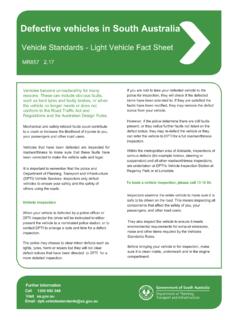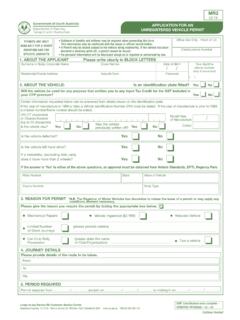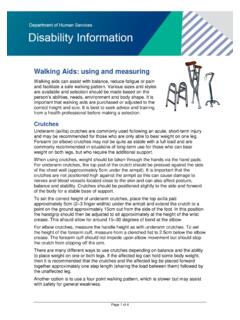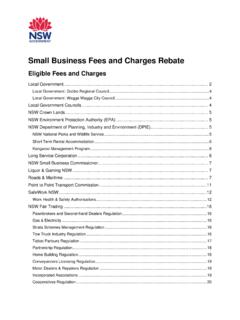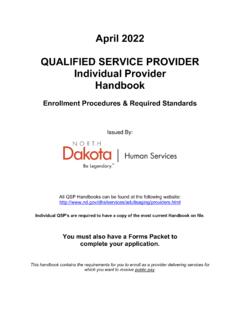Transcription of Trainee Guide for Heavy Rigid (HR) and Heavy Combination ...
1 1 Trainee Guide FOR Heavy Rigid (HR) AND Heavy Combination (HC) competency based training AND assessment (CBT&A) _____ Trainee s Name 2 FOR THE Trainee PLEASE READ This information is to ensure that you have a clear understanding of the qualifications of your Driving Instructor who is training or assessing you for your licence. INSTRUCTOR ENDORSEMENTS COLOURS Instructor Authorisation Yellow Endorsement Conduct competency based training and assessment Red Endorsement Conduct vehicle on Road Tests All Motor Driving Instructors must display their Instructor s Licence when either training or assessing trainees. The Instructor s Licence is for your benefit and may be marked with a coloured endorsement. It is in your interest to check that the instructor is appropriately qualified to perform the service you require. WITHOUT A COLOURED ENDORSEMENT A Motor Driving Instructor who has an Instructor s Licence WITHOUT a Yellow or Red coloured endorsement can only train trainees in the class of driver s licence that the Instructor holds.
2 As an instructor they do not hold any examiner authorisation; therefore, they CANNOT sign off any Task in the competency based training and assessment course or conduct any vehicle on Road Tests (VORT). These Instructors cannot train trainees who are exempted from the Heavy vehicle Graduated Driver Licensing Scheme, by undertaking the training In Lieu of Experience (TILE) program. The only Instructors that can conduct training and assessments on TILE students must hold the HC Authorisation and display their Instructor s Licence with a yellow endorsement. WITH A YELLOW AUTHORISED EXAMINER ENDORSEMENT A Motor Driving Instructor who has an Instructor s Licence with a Yellow coloured endorsement can train and assess trainees in tasks for the competency based training and assessment course for the particular classes of licence stated. These Instructors have qualified by passing an Authorised Examiner Course conducted by the South Australian Department of Planning, Transport and Infrastructure.
3 WITH A RED AUTHORISED EXAMINER ENDORSEMENT A Motor Driving Instructor who has an Instructor s Licence with a Red coloured endorsement is authorised to conduct vehicle on Road Tests (VORT) for the particular classes of licence stated. These Instructors have qualified by passing the Authorised Examiner Course conducted by the South Australian Department of Planning, Transport and Infrastructure. 3 SUMMARY OF competency based training COURSE TASKS (To be completed by the Accredited Instructors only) HR/HC Student Name: _____ Licence Number: _____ Instructor No: _____ Instructor Name: _____ (PLEASE PRINT NAME) TASK CBT & A TASKS MDI START DATE No. No. DATE ASSESSED INTRODUCTION TO THE vehicle Entering and Leaving Driver s Cab In Cab Preparation Knowledge of Basic Controls DRIVING THE vehicle Starting Up Procedure Shut Down Procedure Gear Changing Kerb Stop Procedure - Level Ground Moving Off Procedure - Level Ground Kerb Stop Procedure - Uphill Moving Off Procedure - Uphill Kerb Stop Procedure - Downhill Moving Off Procedure - Downhill Driving straight ahead at Controlled Intersections and Pedestrian Crossings Turning the vehicle , to the Left Turning the vehicle , to the Right Gear Changing - Events Changing Lanes.
4 Apply system Safe Driving Strategies Hills and Open Road Drive plus Review Final Drive and Review MANOEUVRES Couple Prime Mover to Trailer Couple Trailer to Heavy Rigid vehicle Uncouple Trailer from Prime Mover Uncouple Trailer from the Heavy Rigid vehicle Reversing - To the Left ( HC ) Reversing - To the Left ( HR ) Reversing - Straight Line MISCELLANEOUS Check Stop Inspection Breakdown Procedure Pre-Departure Check Post-Operation Check Notes: The Instructor s name and number recorded at the top of this page must be the Instructor who conducts the Final Drive and Review. The name and number of the Instructor must not be placed on this page until assessing task The column marked MDI No. is to be filled out only by the Instructor who has assessed the appropriate task or tasks. 4 training AND assessment RECORD DATE TRAIN & ASSESS TOTAL INSTRUCTORS NAME HOURS HOURS COMMENTS The training and assessment hours recorded in the column above must only be the hours for the client who is issued with this book.
5 If the Instructor is working with two clients together and the total hours for both clients is 6 hours, the hours recorded in the column above would be 3 hours. STANDARDS CLARIFICATION ON 2 CONSECUTIVE, BUT SEPARATE OCCASIONS MEANS: If you successfully demonstrate a task on the first occasion, the Instructor must do some other training not related to that task or may assess another task, but a minimum period of twenty (20) minutes must elapse before a second request of the original task is made to you. After that request, if you perform a further accurate demonstration of the original task without any additional training or assistance in that task, the Instructor will sign the task off. If the second request is unsuccessful, the task must be re-assessed from the beginning ( on 2 consecutive, but separate occasions). 5 ABOUT THIS Trainee Guide This Guide is your property; it must be given to your Instructor at the beginning of each driving lesson and should be returned to you at the end of each session.
6 Assessments will not be conducted without this Trainee Guide . The information in this Guide is to give you an understanding of the driving requirements of each task that you will have to demonstrate to a required standard. Each task has requirements to be achieved before your Instructor can sign it off. Your Instructor will explain these requirements at the beginning of each new task for which you are being trained and assessed. This Trainee Guide will be a record of the tasks you have achieved and also the amount of hours taken. At any time during the training , you must produce it, on request, to an assessment Officer from the Department of Planning, Transport and Infrastructure (DPTI). Occasionally, an assessment Officer from DPTI may ride with you during a training and assessment session with your Accredited Instructor. These Officers are looking at how your Instructor is training and assessing your driving.
7 This ensures that all training and assessments being applied by your Instructor meet the Government Standards required for licensing. These Auditors will not become involved in your training or interfere with the result of any assessment conducted by your Instructor. Once you have completed your training and all the tasks have been signed off, the Accredited Instructor will issue you with a Certificate of competency . Upon presentation of the certificate and the appropriate identification at a Service SA Customer Service Centre, your drivers licence will be upgraded. The examiner must remove the summary sheet and all assessment records that are in the Trainee Guide and retain them for a minimum of 24 months. You may retain the remainder of the Trainee Guide . Enquiries and complaints If your enquiry or complaint involves the standard of training or the assessment of tasks in the CBT&A course, please forward your complaint in writing to: Notes for the Accredited Instructor: 1.
8 This Trainee Guide must be issued to the Trainee before any competency based training or Assessments may commence. 2. The tasks in this Trainee Guide must be signed off by the Accredited Instructor, and counter signed by the Trainee , during or at the end of each session. The Trainee Guide must reflect the current status of the standard of competency that the Trainee has achieved for any task. 3. RECOGNITION OF CURRENT COMPETENCIES (RCC) does not apply to trainees in any task in this Trainee Guide . If used on other trainees, it will only affect the driver training , not the assessment procedure. No part of this document may be reproduced or transmitted in any form or by any means for any purpose without the express written permission from DPTI. 6 THE SYSTEM OF vehicle CONTROL Definition A system or drill, each feature of which is to be considered, in sequence, by the driver when approaching and negotiating any hazard.
9 HAZARD Definition A hazard may be any physical feature (such as traffic lights, a roundabout, intersection, bend or crest) or any potentially dangerous traffic situation developing ahead. This may be interpreted as anything which will either cause you, or have the potential to cause you, to change speed or direction. FEATURE OF THE SYSTEM THE APPROACH NAME OBJECT 1. Course Selected To determine the course to be taken to negotiate the hazard. 2. Mirrors/then signal To check for following and overtaking traffic and to give a clear signal of intention to other road users that you intend to turn or diverge. 3. Brake To reduce speed to a safe rate of approach to arrive at the hazard Note: Brakes should not be released until a clear view into the hazard has been obtained. DECISION POINT STOP OR GO? DECISION TO GO 4. Gears and Mirror (s) (Look all around) To select an appropriate gear for flexible control and to recheck for following and overtaking traffic including any blindspots.
10 5. Evasive Action To take any evasive action as necessary, for example: a horn warning this would be a very rare occurrence. 6. Normal Acceleration To leave the hazard safely having regard to the road surface and traffic conditions. If all features are considered in sequence correctly, evasive action should not be required, care should be taken under acceleration to eliminate the risk of skidding. 7 VEHICLES AND LOADS REQUIRED FOR CBT&A vehicle REQUIREMENTS All vehicles used for CBT&A must have proof of registration, be roadworthy and in a suitable condition for training . Only one type of transmission and configuration of vehicle is to be used throughout the entire CBT&A process including the final drive assessment . TRANSMISSION TYPE Manual Transmission Manual transmissions feature a driver-operated clutch and a movable gear lever. Automatic Transmissions An automatic transmission is one that changes gears by itself according to the speed of the vehicle without any action by the driver.
